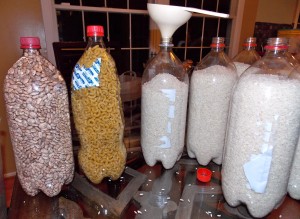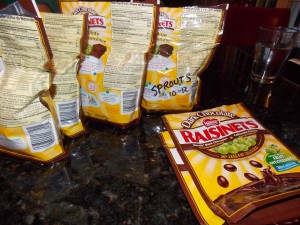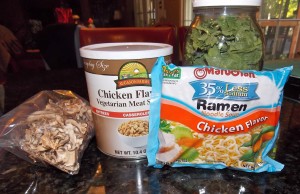For our family, as I discussed in last month’s post, there are a number of obstacles to long term food storage. It is not only about packaged vs. fresh foods, but some of the traditional prepper foods and storage methods are EXPENSIVE! Food that comes in #10 cans can be very pricey, and putting away my own foods in mylar and buckets was just not working for me (though I did it heavily in those first few months). Last is a common prepper notion that anyone will eat anything if they are hungry enough (and by this people usually mean beans and rice). That is just not a realistic approach with kids, especially if you are trying to get them to support your prepper habits. At our house we have embarked on ways to incorporate long term food storage into everyday life so that if the SHTF, the food will not be foreign and mysterious (aka “ICKY”).
 The ideal of prepper packaging for the apocalypse seems to be centered around big mylar bags and 5-gallon buckets. I personally hate both of these things. I hate the big bag because it costs money, it makes it almost impossible to check on your food or to use it in any sort of rotation. And I really hate the buckets because they are round which wastes space on shelves. They also weigh a ton and make it impossible for me to move without assistance, which I may not have in an emergency. I do occasionally use the thick gallon sized mylar bags for food storage, but more
The ideal of prepper packaging for the apocalypse seems to be centered around big mylar bags and 5-gallon buckets. I personally hate both of these things. I hate the big bag because it costs money, it makes it almost impossible to check on your food or to use it in any sort of rotation. And I really hate the buckets because they are round which wastes space on shelves. They also weigh a ton and make it impossible for me to move without assistance, which I may not have in an emergency. I do occasionally use the thick gallon sized mylar bags for food storage, but more  frequently I recycle other containers. Currently I am storing beans, rice, flour, oatmeal and macaroni noodles in 2-liter soda bottles with two 100cc oxygen absorbers. On the internet you will see some debate as to the long term viability of these bottles, but I think as long as you are using the thicker PET bottles, there is no reason not to use them. Please note that water bottles are much thinner than soda bottles and I only use those for water. I feel the pros outweigh any cons. So far they have a beautiful air tight seal (as evidenced by their deflation caused by the 02 absorbers), I have the ability to visually check my product, they are much easier to move around by myself, and I can use my long term food storage as needed in smaller quantities without opening an entire 5-gallon bucket of something. The other container that I have taken to re-using is small mylar bags from some of our regular food items. For instance a bunch of candies and even prunes come in small mylar bags with ziplock seals on the top (at our house it’s Raisinettes). I clean these bags out and use them for storing popcorn (my husband’s favorite treat) and bean sprout seeds. These smaller bags are the perfect size for both. I treat them just like any purchased mylar bag: insert my food, drop in a 100cc O2 absorber and heat seal it as usual (but just below the ziplock seal area).
frequently I recycle other containers. Currently I am storing beans, rice, flour, oatmeal and macaroni noodles in 2-liter soda bottles with two 100cc oxygen absorbers. On the internet you will see some debate as to the long term viability of these bottles, but I think as long as you are using the thicker PET bottles, there is no reason not to use them. Please note that water bottles are much thinner than soda bottles and I only use those for water. I feel the pros outweigh any cons. So far they have a beautiful air tight seal (as evidenced by their deflation caused by the 02 absorbers), I have the ability to visually check my product, they are much easier to move around by myself, and I can use my long term food storage as needed in smaller quantities without opening an entire 5-gallon bucket of something. The other container that I have taken to re-using is small mylar bags from some of our regular food items. For instance a bunch of candies and even prunes come in small mylar bags with ziplock seals on the top (at our house it’s Raisinettes). I clean these bags out and use them for storing popcorn (my husband’s favorite treat) and bean sprout seeds. These smaller bags are the perfect size for both. I treat them just like any purchased mylar bag: insert my food, drop in a 100cc O2 absorber and heat seal it as usual (but just below the ziplock seal area).
I find those #10 cans to be a bit of a mystery. Typically, the types of foods that I buy in #10 cans or in buckets are things that I cannot store myself, primarily protein items and vegetables that are tough to store/delicate to handle, or luxury items like butter and sour cream which would dress up storage foods for recipes. TVP, powdered eggs & cheeses, spinach and broccoli are items that we have recently been purchasing in cans. We had absolutely no experience with them and were not sure if we even wanted to buy them in cans or buckets without trying them first (Costco and Sams sells in bucket sizes). Fortunately, on their websites Auguson Farms and Shelf Reliance sell most of their products in small soup sized cans/mylar containers that are perfect for sampling. We ordered an assortment and are working our way through them to see which we want to buy in bulk. I will mention that on the Costco website, one of the food manufacturers (Thrive) sells their items sealed in a mylar pouch, in a bucket with a gamma seal (reusable lid), while many other companies only put the item directly into a traditional bucket with a one time use lid. In any event, like everything else, these dehydrated foods take practice to be able to use them effectively. And by trying the sample sizes, we feel we are making more specific choices about which ones we would truly use in an emergency.
 So what do I store that makes all this food storage work for our family? How do I tie it all together to get the kids to eat it and still make it nutritional? For us it is all about the components. As long as the food contains a main item that my kids recognize, they can usually be coaxed into eating it. For us that is usually vegetables. My kids will never willingly drink powdered milk, so I make sure I have a bunch of their favorite cereals stored in mylar for long term (stashed away where they don’t see it in the pantry). Ramen anyone? It’s filled with empty pasta calories and high sodium, right? But after living in Japan, ramen is a staple in our household, much like rice, pasta and potatoes. I buy the low sodium ramen and then I start adding the nutrition in, normally fresh stuff. But with a little retraining, we are using chicken TVP, dried mushrooms, green onions and spinach (all that I dehydrated myself and vacuum sealed in mason jars), and fresh bean sprouts (that we grew ourselves in only a few days inside the house). Dried spinach seems to have a much stronger flavor than fresh (so don’t use as much). Another item that I store is curry powder, which can be added to any bean or rice dish for flavor (for us this is a familiar flavor after living overseas for so long). I have also started routinely using dehydrated vegetables in our regular recipes and have discovered that the kids often don’t recognize the difference. We also have a favorite “no-bake” cookie recipe which uses oatmeal, chocolate, sugar, and peanut butter and is made on the stove top (perfect without electricity!). It has been hard, but I am really trying to find ways to store foods that are familiar. Also, your food preps aren’t any good if you don’t have a list of recipes to go with it. As for my husband the bean hater…he will willingly eat almost anything if I can promise him that bowl of popcorn at the end of the day!
So what do I store that makes all this food storage work for our family? How do I tie it all together to get the kids to eat it and still make it nutritional? For us it is all about the components. As long as the food contains a main item that my kids recognize, they can usually be coaxed into eating it. For us that is usually vegetables. My kids will never willingly drink powdered milk, so I make sure I have a bunch of their favorite cereals stored in mylar for long term (stashed away where they don’t see it in the pantry). Ramen anyone? It’s filled with empty pasta calories and high sodium, right? But after living in Japan, ramen is a staple in our household, much like rice, pasta and potatoes. I buy the low sodium ramen and then I start adding the nutrition in, normally fresh stuff. But with a little retraining, we are using chicken TVP, dried mushrooms, green onions and spinach (all that I dehydrated myself and vacuum sealed in mason jars), and fresh bean sprouts (that we grew ourselves in only a few days inside the house). Dried spinach seems to have a much stronger flavor than fresh (so don’t use as much). Another item that I store is curry powder, which can be added to any bean or rice dish for flavor (for us this is a familiar flavor after living overseas for so long). I have also started routinely using dehydrated vegetables in our regular recipes and have discovered that the kids often don’t recognize the difference. We also have a favorite “no-bake” cookie recipe which uses oatmeal, chocolate, sugar, and peanut butter and is made on the stove top (perfect without electricity!). It has been hard, but I am really trying to find ways to store foods that are familiar. Also, your food preps aren’t any good if you don’t have a list of recipes to go with it. As for my husband the bean hater…he will willingly eat almost anything if I can promise him that bowl of popcorn at the end of the day!
So what secret food storage tips do you use? Any special ingredients in your closet that we might like to hear about?

Good stuff! I’m using a lot quart mason jars and vacuum sealing them with my Foodsaver. When were you in Japan? I lived in Misawa many, many years ago.
We have been back from Okinawa about 18months. I also vacuum seal mason jars with my dehydrated foods. I love that they are reusable!
I never thought of using 2 liter bottles to store dried food storage products. It sounds like a great idea.
Just did ten more bottles today using up the last of my oxy absorbers- beans, macaroni, flour, cocoa, popcorn, oatmeal. The other plus is that if you have limited storage space, you can stash them in odd places around the house and if they get dusty then you just rinse them off. It’s not like mylar which you have to be careful of tears which limits how you store it. I also have a “stash” started at my mom’s house in a closet that I add to every time we visit.
Beans and seeds keep longer than any other food but who wants to eat boiled beans all the time?
How about sprouting those beans?
These and other sproutables will keep for years (decades perhaps) and they are cheap and compact foods.
I made few really simple sprouters out of 2 plastic stackable cups and a lid from a jar of instant coffee. You get more than enough sprouts in one set up in 3 days to double the volume of a can of progresso soup. So with 3 you can have a batch of sprouts every day. I have made sprouts from several beans / seeds such as lentils (10 years+ old) mung beans, black eyed peas, garbanzo beans etc (I don’t like pinto beans and they do not sprout as well as some other beans):
http://www.instructables.com/id/Make-This-Sprouter-It-Works-Great/?ALLSTEPS
This is probably one of the most important things a prepper can do to make sure they have enough food. Buy lots of sprout able beans and seeds and have a way to sprout them. Dehydrated foods become bigger when you re-hydrate but there is a limit. After that limit is hit you are just watering down dehydrated food, With sprouts, they are re-hydrated to the limit in about 12 hours. After that they grow. So you potentially get a lot more food with sprouts than with other dehydrated foods. A few cubic feet of beans and lentils is a massive amount of food when sprouted.
Lux
We like the food from Shelf Reliance. Have you tried the Scrambled Egg mix. It is very good and the freeze dried Pineapples are out of this world!
(edited to remove link to specific dealer, and claim of a discounted price)
I sprout using a mason jar, a piece of cheescloth, and a rubber band. Put about 1/2 cup of sproutable beans/grains in the jar and soak in water overnight. In the morning put the cheescloth over the top and fasten with the rubber band. Then drain off the water and put the jar on its side in a sunny windowsill. Once a day, rinse the sprouts with water and immediaely drain off. In a few days you’ll have a jar stuffed with sprouts. My husband, I, and our chickens really like them. You can sprout a whole lot of stuff: lentils, beans, wheat, ect.
very interesting! im gonna try this out myself!
Pingback: Cheap Long Term Food Storage: Store Food for Emergencies without Breaking the Bank
I enjoyed your article and would like to try food storage in plastic bottles getting away from mylar bags. My question is do you wash them with any special soap other regular dish soap. And do you sterilize the bottles prior to filling them? Thank you.
I want to put up some rice and beans in miller lite screw top cans and 2 liter bottles . I was going to take a new brake line tubing and introduce dry nitrogen in the bottom as its filled then the absorber packs for any remaing oxygen
The idea of putting the grains in the plastic bottles is brilliant! I think it works only short-term though, as the plastic doesn’t allow any circulation between the grains, so any moisture is trapped in there.
Pingback: Momma Bear: Sequestration, Military Life & Our Growing Family | TraceMyPreps